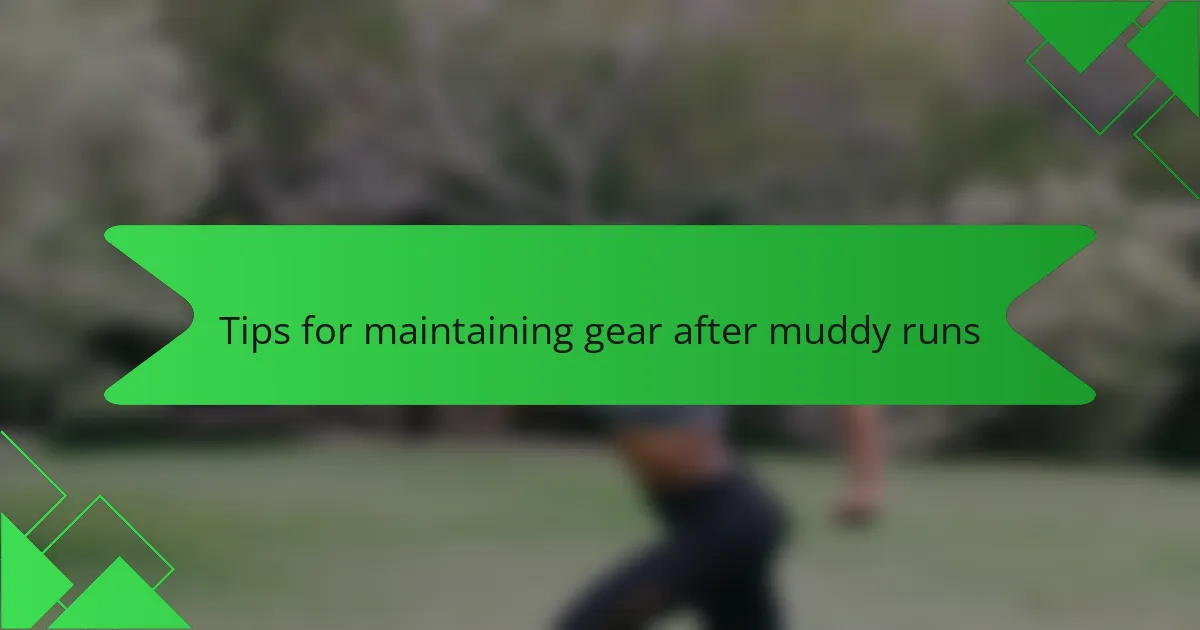Key takeaways
- Muddy runs require a unique focus due to unpredictable terrain, demanding both physical and mental adaptability.
- Essential gear includes trail shoes with good traction, moisture-wicking apparel, gloves for better grip, and hydration packs for staying hydrated.
- Key footwear features should include traction, water drainage, lightweight design, and comfort for effective performance on muddy surfaces.
- Regular maintenance like immediate cleaning and proper washing methods is crucial for extending the life and performance of gear after muddy runs.

Understanding muddy runs in obstacle course racing
Muddy runs are more than just a messy challenge; they transform the entire obstacle course experience. From my perspective, the slippery, thick mud doesn’t just slow you down—it changes how your body moves and tests your balance in ways that dry terrain never does. Have you ever felt that sudden loss of footing and realized it wasn’t just your muscles working harder but your mind constantly recalibrating to stay upright?
What I’ve learned from countless muddy runs is that the terrain demands a different kind of focus. The mud’s unpredictability can make even the simplest obstacle feel like a puzzle. It’s almost like the course is alive, forcing you to be creative and adaptive with every step. I remember a race where the mud was so deep it clung to every part of my shoe; what would normally be a sprint turned into a slow, strategic crawl.
Understanding the nature of these runs means embracing both the frustration and the thrill. It’s a full sensory experience—cold, wet, heavy, and often exhausting—but that’s also what makes muddy runs so addictive. Have you noticed how the challenge of pushing through such tough conditions brings out an unexpected sense of accomplishment? It’s those moments that keep me coming back, gear in hand, ready to face the mud again.

Essential gear categories for muddy runs
When it comes to muddy runs, having the right gear in key categories can make all the difference between a challenging ordeal and an enjoyable adventure. I’ve learned from experience that focusing on essentials like footwear and apparel not only protects you but also boosts your confidence as you tackle slippery, unpredictable terrain.
Based on my many muddy races, here’s what I consider essential for these grueling conditions:
- Trail Shoes with Good Traction: You want shoes that grip well in wet, slippery mud to prevent slipping and maintain momentum. I’ve ruined more than one race by underestimating this.
- Moisture-Wicking Apparel: Quick-drying clothes keep you comfortable and reduce chafing when soaked with mud and water. I never skip this anymore after suffering through skin irritation.
- Gloves: Protect your hands from cuts and improve grip on obstacles, especially when everything is slick.
- Headwear: A cap or band helps keep mud and sweat out of your eyes—trust me, running blind in the mud is no fun.
- Hydration Pack: Staying hydrated is crucial, but not all packs work well when you’re covered head to toe in muck, so look for something secure and easy to access.
Each category targets a different challenge that muddy runs throw at you, and I’ve found that getting these basics right elevates your entire run.

Key features to look for in muddy run gear
Choosing the right gear for muddy runs means prioritizing features that balance durability and comfort. From my experience, nothing is more frustrating than gear that becomes heavy or restrictive when soaked in mud. I’ve learned to zero in on materials that dry quickly and shoes that offer excellent traction without sacrificing flexibility.
One key feature I always check is how well the gear handles moisture—whether it repels water or allows sweat to escape efficiently. For example, I once wore a jacket that soaked up water like a sponge, making every step feel like I was carrying extra weight. That taught me to invest in breathable, moisture-wicking fabrics that keep me dry inside while facing muddy conditions.
- Quick-drying, moisture-wicking materials
- Lightweight and flexible shoes with enhanced traction
- Durable construction resistant to abrasion and tearing
- Secure, adjustable fittings to prevent slippage
- Easy-to-clean fabrics to reduce post-race hassle
- Good ventilation to regulate body temperature in wet conditions

Choosing the best footwear for mud conditions
Choosing the best footwear for mud conditions is crucial because the right shoes can make or break your muddy run experience. From my own races, I’ve learned that shoes with excellent traction and quick-drying materials help me maintain confidence on slippery terrain. Without the right grip, I often found myself slipping, which not only slowed me down but also drained my energy and focus.
| Feature | Importance for Muddy Runs |
|---|---|
| Traction | Essential for preventing slips; aggressive lugs and deeper tread patterns perform best |
| Water Drainage | Allows mud and water to escape quickly, keeping feet lighter and reducing discomfort |
| Weight | Lighter shoes reduce fatigue, particularly when wet from mud and water |
| Durability | Withstands rough terrains and abrasive mud without falling apart |
| Comfort | Provides cushioning and support to protect feet during long, challenging races |

Personal experiences with gear performance
When I first tried a pair of trail shoes without proper traction, I quickly learned how unforgiving muddy terrain can be. Slipping repeatedly not only frustrated me but also chipped away at my confidence mid-race. It made me realize that gear performance isn’t just about comfort—it’s about trust between you and your equipment when every step counts.
I once entered a race wearing gloves I thought were durable, only to find they tore apart after a few obstacles. That left my hands exposed and made gripping slippery surfaces a nightmare. It’s moments like those when you appreciate the value of testing gear beforehand rather than assuming it will hold up under muddy pressure.
Have you ever felt the difference a lightweight, quick-drying shirt makes when sinking into cold mud? I have, and it transformed my entire experience. Instead of being weighed down and chilled, I stayed agile and focused, proving to me that small gear choices can have a huge impact on how you perform and feel on race day.

Tips for maintaining gear after muddy runs
After finishing a muddy run, I always prioritize cleaning my gear right away. Letting mud dry on shoes or clothes makes it harder to remove and can damage materials over time. From my experience, soaking items briefly in cold water before washing helps preserve the fabric’s integrity and keeps colors vibrant.
Regular maintenance doesn’t just extend gear life—it also keeps performance consistent. I once neglected cleaning my trail shoes after a particularly muddy race, and noticed they lost grip in the next event. That taught me how crucial proper care is for safety and comfort in future runs.
| Cleaning Method | Effectiveness & Notes |
|---|---|
| Immediate Rinse with Cold Water | Easily removes fresh mud without damaging materials; prevents stains |
| Soaking Before Washing | Loosens stubborn dirt; helps maintain fabric texture and color |
| Machine Wash on Gentle Cycle | Recommended for clothes; prolongs lifespan if done properly with mild detergents |
| Air Dry | Prevents shrinking and preserves shape better than heat drying |

Recommendations for reliable muddy run gear brands
When it comes to reliable muddy run gear brands, I’ve found that some names consistently deliver when the mud gets thick and unforgiving. Salomon, for example, stands out with their trail shoes that combine aggressive grip and durability, making slippery descents feel manageable rather than terrifying. Have you ever noticed how a trusted shoe brand can give you the confidence to push harder just by how secure your footing feels? That’s exactly what Salomon does for me.
On the apparel side, brands like Under Armour and Patagonia have never let me down. Their moisture-wicking fabrics dry fast and hold up against constant abrasion, which means no distractions from soaked, heavy clothes mid-race. Plus, their gear is designed with an athlete’s movement in mind, so it doesn’t restrict or irritate. I remember a muddy run where my Under Armour shirt felt like a dry second skin despite the soaking—comfort that kept me focused.
For accessories like gloves and headwear, I swear by GripGrab and Buff. GripGrab’s gloves have protected my hands through countless slippery climbs, staying intact when others shredded too quickly. And Buff’s multifunctional headwear keeps the mud and sweat out of my eyes without constant adjustments. Have you ever reached a muddy obstacle and wished your gloves could have handled just one more slip? Finding gear that doesn’t quit mid-run is a game changer.
